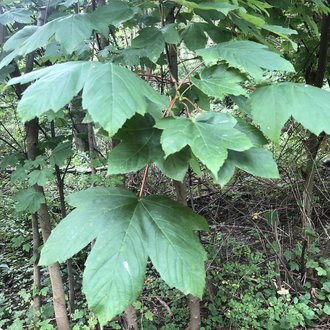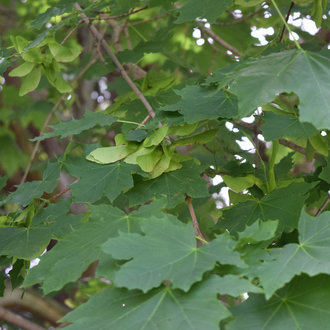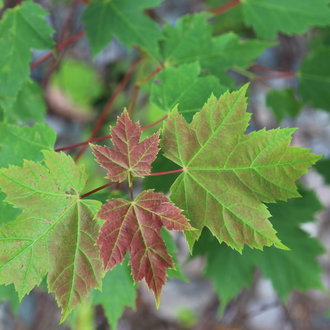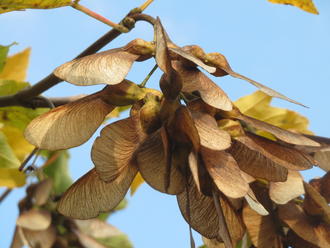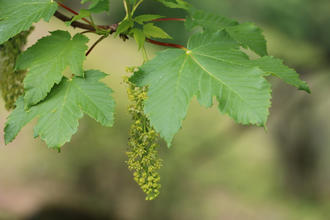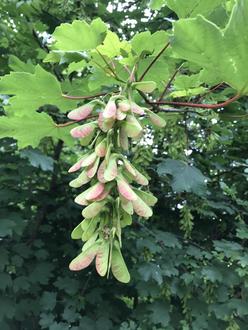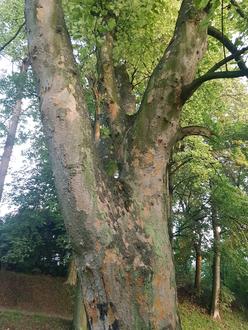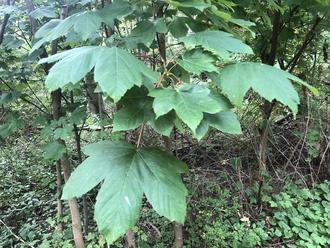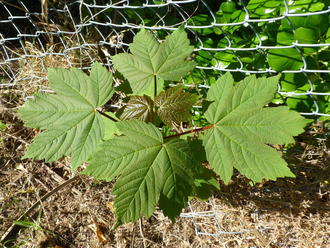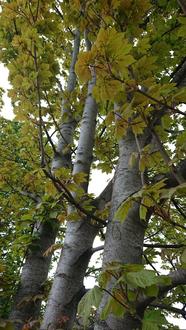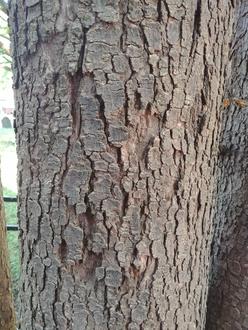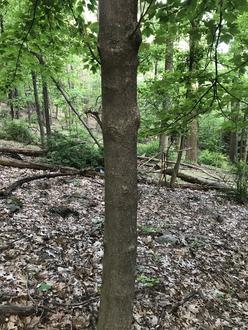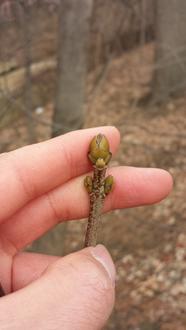Sycamore Maple (Acer pseudoplatanus L.)
↑Summary
A large maple with invasive potential. In the UK, referred to only as "sycamore"; in the U.S. this name is reserved for the American sycamore and other trees of the Platanus genus.
↑Range - Expand
| Legend | Color |
| Introduced or Not Present | |
| Introduced |
This tentative map is based on our own research. It may have limited data on Canada and/or Mexico, and there is some subjectivity in our assignment of plants as introduced vs. expanded. Read more in this blog post.
Although this plant occurs somewhere in each of these regions, it may only occur in a small part of some or all of them.
↑Similar Plants
↑Habitat
As this species is not widely established in North America, its habitat preferences here are not well-known. In its native range in central Europe, it is most common in moist areas in mountains, and is often associated with birch (Betula sp.) and fir (Abies sp.) as well as Beech (Fagus), and Norway spruce (Picea abies). In riparian areas it is associated with alder (Alnus sp.), ash (Fraxinus sp.) and elm (Ulmus sp.). In its native range it is less shade-tolerant than beech and only a climax species on unstable strata, such as talus slopes.
In North America it is most common in anthropogenic habitats, including cities, towns, and suburban areas, as well as parks and wild areas adjacent to these areas, and it can also colonize old fields. In the wild, it can also be found in floodplain forests and forest edges. It seems to tolerate a wide variety of soil textures so long as they are sufficiently nutrient-rich, especially high in nitrogen, and is particularly partial to nutrient-rich waste ground and semi-wild woodlands. It is tolerant of alkaline but not acidic soils, requiring pH ranging from 5 to 8. It prefers moist conditions, but is also drought-tolerant once established. Its greater tolerance of road salt and pollution, including heavy metals, makes it better suited to urban areas than the native sugar maple. It is able to grow in coastal locations.
Different sources variably describe it as shade-tolerant and shade-intolerant, and inconsistently describe it as tolerant or intolerant of flooding. It is likely more shade-tolerant than most species that also occur in floodplains and forest edges, but probably less shade-tolerant than sugar or Norway maples. It is likely tolerant of some flooding but not of the prolonged flooding found in the wettest, lowest sites in bottomlands.
↑Life Cycle
Sycamore maple is a large, long-lived tree.
Seed production typically begins around 25-30 years of age, but seed production can happen early, in rare cases within a few years. Seedlings are shade-tolerant, but the seed itself does not persist in the seed bank long-term, although a few seeds may germinate later than the first year. Most seedlings die in the first year, but survival of second-year seedlings is high.
Trees can live up to 500 years.
↑Control
As with most species that have invasive potential but are not widely planted, the most important thing is to avoid planting this species, and remove it ASAP where it has been planted in landscaping, giving special priority to plantings near suitable wild habitat. Where it is established, it is often difficult and costly to control. This species often occurs together with Norway maple and, as control methods are similar, it is usually most effective to target both species together.
When mature trees are present in an area, especially when they have good form, they can be harvested for timber. When it is not possible or practical to cut down mature trees, they can be girdled, which is best done in spring.
Seedlings can be pulled by hand with gloves and a trowel, and smaller saplings can be removed with a shovel or uprooting tool.
Any trees top-killed by cutting or girdling while leaving their root systems intact will often resprout and will require revisitation to kill sprouts. Treating stumps with herbicide can prevent resprouting.
Like other maples, it does not persist long-term in the seed bank, so once the seed sources of nearby adult trees have been removed, and all seedlings have been removed over a period of about 3 years, it can be completely eliminated from an area.
Where they constitute a large component of the forest, removal of this species and the related Norway maple can result in significant disruption to the ecosystem, and as such removal of mature trees is best done incrementally, and combined with planting and/or seeding in of native species. This tree can be replaced by native maples, including sugar maple on rich mesic sites, box elder and silver maple in floodplains, red maple on a variety of sites, or where it occurs in the pacific northwest, bigleaf maple.
↑Uses
This species is uncommonly used as a landscaping plant in the US, mainly urban areas, where it has been valued for its tolerance of salt and pollution, and to a lesser degree its ornamental bark. It is best avoided as it may have potential to become invasive. The fact that it has not yet become widely invasive may be mostly due to it not being widely planted. It also has less interesting fall color than some of the native maples, including red and sugar maple.
The sap can be used to produce syrup, much like sugar maple.
This species can be used for wood; like other maples, the sapwood is most commonly used. its wood is intermediate in hardness between the maples considered "hard maple" (sugar, black, etc.) and those considered "soft maple" (red, silver, etc.) Like other maples, it is generally easy to work with, but not particularly durable. It is not widely available, but where available tends to be relatively affordable. This species is more important for timber in its native range where it is more abundant.
↑Related Plants
This species co-occurs with numerous other maples (Acer sp.), both native and introduced. The closest relatives of this species are not found in North America. Genetic analyses suggest that, among the North American maples this species is probably most closely related to the sugar maple, followed by red and silver maples. The Norway maple is probably less closely related than these, and the visually-similar mountain maple is deceptive in that it is even less-closely related.
↑Notes
This species has become established in the wild in numerous countries beyond its native range, spanning wildly different climates, besides the U.S., also including New Zealand, Argentina, Algeria, Kazakhstan, Uzbekistan, Myanmar (Burma), Sweden, and the UK. This lends further evidence that this species may need to be approached with caution due to invasive potential.
↑Links & External Resources
• Sycamore Maple | The Wood Database (About This Site)
• Acer pseudoplatanus (Sycamore Maple) | USDA PLANTS Database (About This Site)
• Acer pseudoplatanus | Go Botany (About This Site)
• Acer pseudoplatanus (Sycamore Maple) | Missouri Botanical Garden Plant Finder (About This Site)
• Sycamore Maple | Virginia Tech Dendrology Factsheets (About This Site)
• Acer pseudoplatanus | Biota of North America Project (BONAP) (About This Site)
• Acer pseudoplatanus | NatureServe Explorer (About This Site)
• Sycamore Maple | Maryland Biodiversity Project (About This Site)
• Acer pseudoplatanus L. (Sycamore Maple) | Digital Atlas of the Virginia Flora (About This Site)



